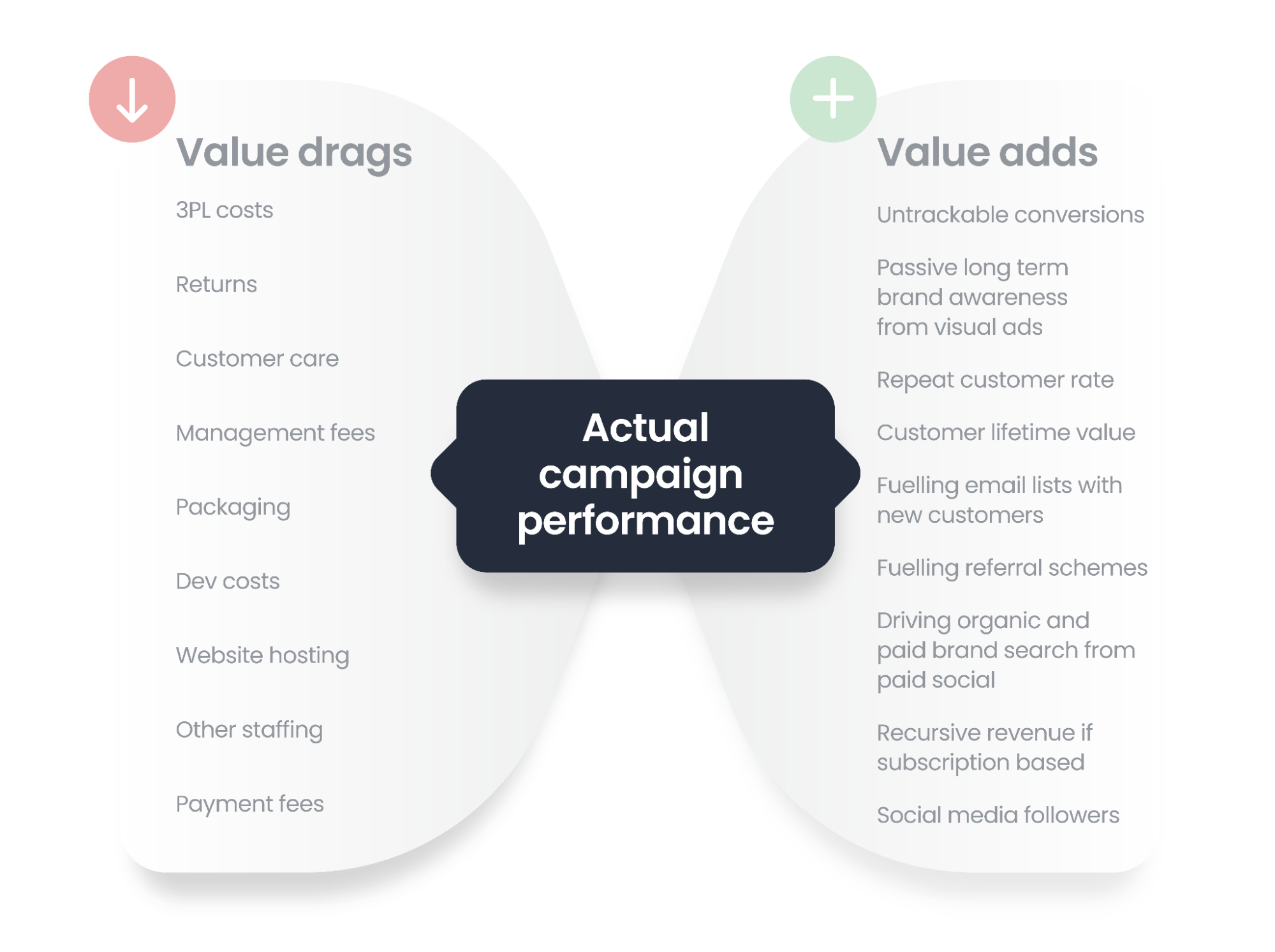Many things have changed in paid media. With the introduction and wild success of automated bidding in Google Ads, dynamic creative formats taking over, and new aggregated campaign formats like Performance Max, it can often feel like by standing you’re struggling to keep up. Even falling behind at times.
On the specialist side, there’s never a shortage of additional new technical challenges and obstacles to overcome with attribution, Google Consent Mode and much more.
When it comes to the client relationship side, though, the essential questions have remained the same: “How do we know if it’s working?” and “Is it actually making money?”
We have an interesting dichotomy whereby ad channels talk the language of ROAS, while clients are talking in P&L, leaving the specialist somewhat in the messy middle, as we try to get results and scale activity.
It all comes back to commercial underpinning—the secret weapon to bridge the gap between marketing channels and the shareholder/director on the brand side.
We can’t always achieve perfection (and we don’t need to). We can, however, reach a place where machine learning is consistently receiving the right inputs, and achieving the right outputs.
Let’s explore the three key areas that come up most frequently.
Profitability
When talking about achieving an advertising return, an acceptable level is generally covering the product cost and ad spend. That leaves whatever percentage they deem acceptable as the remaining profit per sale.
Example 1 – Basic costs covered
Revenue: £30
VAT: £6
Ad Spend: £10
Product Cost: £10
Margin Value: £4
On a narrow view of per sale only, this is making money (albeit a small amount) and is restrictive enough of a target ROAS of 3:1 or a target CPA of £10. Other direct costs could be included, such as shipping costs, if it’s not charged as an additional fee.
Milestone one (which would come before this) would be for the campaign to be profitable on ad spend. However, that’s not truly generating profit for the business as when you take the basic costs into account, the business, in that instance, is losing money having to service the customers generated from ads.
Example 2 – Profitable on ad spend only
Revenue: £30
VAT: £6
Ad Spend: £20
Product Cost: £10
Margin Value: -£6
Other factors can be considered too, such as customer care, returns and stocking charges, retainer fees. Most of these wouldn’t typically be used when looking at a campaign target per sale, as they dilute significantly as sales volume ramps up.
For the most part, they’re also costs shared across all acquisition channels in the business. To expect paid media to carry these will hinder the machine learning in the campaign’s ability to deliver a sales volume that pairs with a profitable ROAS for overall commercial success.
Typically, the higher your ROAS/lower your CPA, the fewer auctions you’ll be able to enter. That reduces overall potential sales captured from your activity.
Getting the balance right is tricky.
If your campaigns can cover ad spend and basic costs, they will likely be more profitable than most. You can then scale up spend with confidence that it’s commercially viable to do so, diluting other costs as you go.
Return is only one part of commercial performance, though. If it’s not balanced with enough volume, it’s meaningless.
Run rates
It is important to balance our target return over a volume of sales that is significant enough for overall performance to be commercially viable. A campaign hitting a ROAS of 10:1 against five sales per month isn’t going to shift the needle!
A simple and effective way to model whether you’re likely to hit your revenue targets is to calculate a run rate to work alongside your profitability goals with tROAS or tCPA.
Run rates are indicators, not measures of success. Like all averages, they’re subject to change over time. They can be skewed by small data sets in terms of short date ranges, or anomalous days experiencing inflated/deflated performance.
Run rate helps you to understand how your campaign is tracking against monthly/quarterly targets in order to review whether there are changes that can or should be made.
A monthly run rate is simply:
Revenue from ads Month to date/days elapsed * total days in the month.
Run rate should be tracked from around the 10th of the month onwards to avoid short date ranges giving non-statistically significant averages!
Reviewing once per week can really help to understand if sales targets are realistic. If you’re on track, great; if you aren’t, then you can look at the contributing factors to sales volume and start to make informed decisions.
When the volume isn’t there, and it’s a Google Ads-heavy strategy, it’s mostly down to seasonal factors, with users not searching as much, leading to less ability to show ads. There are, of course, a number of other possible scenarios.
Looking at performance this way, there may be times when you want to accept a lower target return for a higher sales volume or vice versa.
The interplay between return and sales volume is an important one; it’s nuanced and moves continuously.
Having your acceptable target return and tracking your sales volume allows you to make commercial-led paid media decisions rather than specialist first. Whilst the latter might be desirable from a channel specialism/best practice perspective, it can lead to a disconnection from the client’s business goals.
Value adds and value drags
Two questions may have occurred to you while reading this post: “What about untracked conversions and attribution?” (if you’re a specialist), and “What about all the other costs involved?” (if you’re more on the business side.)
Both are valid, and both were alluded to in the first section about profitability.
There are other costs incurred in running activity which would weigh down our profitability calculation.
There are also many added values that aren’t measurable and which increase the weight of the actual return from media spend.

On the drag side, many of these costs will dilute as sales volume increases and are spread across all acquisition channels in the business. These costs are fairly immediate in terms of how they correlate with ad acquisition.
On the add side, some can be measured and factored in if you have the data, like repeat customer rate. Bear in mind that there will be some latency to seeing the additional value coming through. It may take 90 days or more to see the additional sale from media spend. It wouldn’t be attributed to ads reporting, so it’s more speculative.
There’s no perfect answer to give on how to consider these in your target setting.
It has to be taken on a case-by-case basis, though a helpful framework is:
If you’re in a growth-focused phase, preferencing sales volume by relaxing targets and expectations. A huge pot of longer-term additional value will help you to maximise acquisition whilst maintaining a degree of profitability.
If you’re in a profitability-focused phase, preferring a target that covers the basics costs as shown. Added value offsetting some if not most of the value drags side will enable you to sustain an acceptable level of spend and return.
Summary
I’ve spent months (and years in some cases) working on this with clients, so it’s an ongoing conversation. It typically ends up settling in the place where basic costs are covered, as shown, and that seems to be the sweet spot, which is why I’ve outlined it above.
There will be seasonal peaks where profitability targets are relaxed to take maximal sales volume, and seasonal troughs where maintaining the target means a lower run rate isn’t compounded down by a negative return, which you’ll really feel in the P&L.
Working this way helps the specialist to feed the right inputs into machine learning on the campaign side, talk to the client on a business level, and, most importantly, know what you’re doing is working when it is!
For the client, it really helps to know that marketing activity is aligning with their business goals. If they know you’re taking into account the impact on P&L when optimising and making changes, you’re going to be in better shape.
Byron Marr is the founder of ProfitSprint Performance Marketing Consultancy.
Want to know if your ROAS is profitable? ProfitSpring make it easier with their ad calculator.




